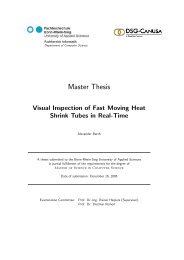Master Thesis - Hochschule Bonn-Rhein-Sieg
Master Thesis - Hochschule Bonn-Rhein-Sieg
Master Thesis - Hochschule Bonn-Rhein-Sieg
Create successful ePaper yourself
Turn your PDF publications into a flip-book with our unique Google optimized e-Paper software.
2. Overview on human-robot <strong>Master</strong> <strong>Thesis</strong> Björn Ostermann page 15 of 126<br />
and robot are still separated, but the human is allowed to enter the robot’s working area. The robot is<br />
working around the human or, if no alternative path is available, waiting for the human to leave the<br />
occupied path.<br />
The flexible fence is realized with only one 3D camera, mounted above the robot and looking<br />
downward at the working area, as depicted in Figure 2.<br />
Working Area<br />
Camera<br />
Robot<br />
Figure 2: Assembly of the workspace<br />
Robot<br />
Since the camera delivers distance information for each observed pixel, the knowledge about an<br />
intruding dynamic object can be build by comparing the distances measured in the empty workspace<br />
(background image – see chapter 5.2.1) with the distances currently observed in the workspace. An<br />
intruding object is recognized through its lower distance values.<br />
As long as there are no intruding objects, which might be dynamic or stationary, in the working area,<br />
the robot can execute its normal tasks. If objects intrude into this guarded working area, the space they<br />
occupy has to be excluded from the robot’s possible movement. This reduced space is depicted by the<br />
red dashed line in Figure 3.














